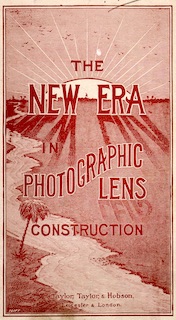Cooke Optics has transferred its archives, an historic collection dating from 1886, to a new permanent home at the Margaret Herrick Library, the main repository of research materials of the Academy of Motion Picture Arts and Sciences, located in Beverly Hills, California. The Cooke Archives, which includes documents, photographs and audiotapes cataloguing the rich history of Cooke lenses as well as the wider development of the film and photography sectors, will be available for research purposes.
 The collection includes original letters from H. Dennis Taylor, inventor of the famous Cooke Triplet patent of 1893. Taylor designed the first five Cooke lenses using his new technology that for the first time solved the problem of astigmatism – uneven definition, particularly with softness at the edges – and achieved sharpness throughout the image plane. The remarkable correspondence shows the emotional political situation that erupted over the Cooke patent between the lens competitors; the design was deemed so good that competitors took the stance that it couldn’t be true.
The collection includes original letters from H. Dennis Taylor, inventor of the famous Cooke Triplet patent of 1893. Taylor designed the first five Cooke lenses using his new technology that for the first time solved the problem of astigmatism – uneven definition, particularly with softness at the edges – and achieved sharpness throughout the image plane. The remarkable correspondence shows the emotional political situation that erupted over the Cooke patent between the lens competitors; the design was deemed so good that competitors took the stance that it couldn’t be true.
“The Cooke Optics archive is an excellent addition to the archival holdings of the Academy’s Margaret Herrick Library, providing comprehensive documentation of the firm’s contributions to a fundamental motion picture technology, spanning the entire history of the cinema itself,” said Howard Prouty, manager, acquisitions, Margaret Herrick Library. “We are honored to have been chosen as the permanent home for this important collection.”
 In the film world, Cooke lenses were famously instrumental in the advent of ‘talking pictures’, which needed faster lenses to capture restricted light, since the traditional arc lights were too noisy to have on sets while recording audio. Cooke lenses are also documented as contributing to the success of the original Technicolor colour process.
In the film world, Cooke lenses were famously instrumental in the advent of ‘talking pictures’, which needed faster lenses to capture restricted light, since the traditional arc lights were too noisy to have on sets while recording audio. Cooke lenses are also documented as contributing to the success of the original Technicolor colour process.
“Our Cooke Archivist, Barbara Lowry, has spent years gathering together this important and comprehensive collection, detailing the very beginnings of what eventually became Cooke Optics and the early lens designs that would change photography forever,” said Tim Pugh, CEO, Cooke Optics. “We are incredibly grateful for Barbara’s labor of love in collating this collection, and her recent retirement seemed like the right time to donate the archive to the Academy of Motion Picture Arts and Sciences. Future generations of photography and film students can now appreciate the significant impact that Cooke had, and continues to have, in the photography and film worlds.”
Cooke’s photographic lenses captured images from many historic moments in the first half of the 20th century; original photographs survive from the infamous Shackleton expedition of 1914-16, and Cooke lenses were used exclusively by British and US armed forces for cartography and photo reconnaissance during World War II.
The acclaimed American photographer Ansel Adams also shot many of his most famous images using a Cooke lens.
While the original archive is now in its new home, two history sections remain on the Cooke website.
The Cooke Compendium at https://cookeoptics.com/t/compendium.html features some of the earliest stills and cine lenses, while a history of how the company and lens designs developed can be found at https://cookeoptics.com/t/history.html
